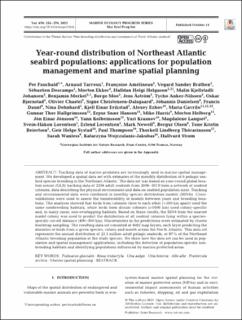| dc.contributor.author | Fauchald, Per | |
| dc.contributor.author | Tarroux, Arnaud | |
| dc.contributor.author | Amelineau, Francoise | |
| dc.contributor.author | Bråthen, Vegard Sandøy | |
| dc.contributor.author | Descamps, Sebastien | |
| dc.contributor.author | Ekker, Morten | |
| dc.contributor.author | Helgason, Halfdan Helgi | |
| dc.contributor.author | Johansen, Malin Kjellstadli | |
| dc.contributor.author | Merkel, Benjamin | |
| dc.contributor.author | Moe, Børge | |
| dc.contributor.author | Åström, Jens | |
| dc.contributor.author | Anker-Nilssen, Tycho | |
| dc.contributor.author | Bjørnstad, Oskar | |
| dc.contributor.author | Chastel, Olivier | |
| dc.contributor.author | Christensen-Dalsgaard, Signe | |
| dc.contributor.author | Danielsen, Jóhannis | |
| dc.contributor.author | Daunt, Francis | |
| dc.contributor.author | Dehnhard, Nina | |
| dc.contributor.author | Erikstad, Kjell Einar | |
| dc.contributor.author | Ezhov, Alexey | |
| dc.contributor.author | Gavrilo, Maria | |
| dc.contributor.author | Hallgrimsson, Gunnar Thor | |
| dc.contributor.author | Snær Hansen, Erpur | |
| dc.contributor.author | Harris, Mike | |
| dc.contributor.author | Helberg, Morten | |
| dc.contributor.author | Jónsson, Jón Einar | |
| dc.contributor.author | Kolbeinsson, Yann | |
| dc.contributor.author | Krasnov, Yuri | |
| dc.contributor.author | Langset, Magdalene | |
| dc.contributor.author | Lorentsen, Svein Håkon | |
| dc.contributor.author | Lorentzen, Erlend | |
| dc.contributor.author | Newell, Mark | |
| dc.contributor.author | Olsen, Bergur | |
| dc.contributor.author | Reiertsen, Tone Kristin | |
| dc.contributor.author | Systad, Geir Helge | |
| dc.contributor.author | Thompson, Paul | |
| dc.contributor.author | Thórarinsson, Thorkell Lindberg | |
| dc.contributor.author | Wanless, Sarah | |
| dc.contributor.author | Wojczulanis-Jakubas, Katarzyna | |
| dc.contributor.author | Strøm, Hallvard | |
| dc.date.accessioned | 2022-06-07T08:00:18Z | |
| dc.date.available | 2022-06-07T08:00:18Z | |
| dc.date.created | 2021-10-29T13:04:13Z | |
| dc.date.issued | 2021 | |
| dc.identifier.citation | Marine Ecology Progress Series. 2021, 676, 255-276. | en_US |
| dc.identifier.issn | 0171-8630 | |
| dc.identifier.uri | https://hdl.handle.net/11250/2997613 | |
| dc.description.abstract | Tracking data of marine predators are increasingly used in marine spatial management. We developed a spatial data set with estimates of the monthly distribution of 6 pelagic seabird species breeding in the Northeast Atlantic. The data set was based on year-round global location sensor (GLS) tracking data of 2356 adult seabirds from 2006-2019 from a network of seabird colonies, data describing the physical environment and data on seabird population sizes. Tracking and environmental data were combined in monthly species distribution models (SDMs). Cross-validations were used to assess the transferability of models between years and breeding locations. The analyses showed that birds from colonies close to each other (<500 km apart) used the same nonbreeding habitats, while birds from distant colonies (>1000 km) used colony-specific and, in many cases, non-overlapping habitats. Based on these results, the SDM from the nearest model colony was used to predict the distribution of all seabird colonies lying within a species-specific cut-off distance (400-500 km). Uncertainties in the predictions were estimated by cluster bootstrap sampling. The resulting data set consisted of 4692 map layers, each layer predicting the densities of birds from a given species, colony and month across the North Atlantic. This data set represents the annual distribution of 23.5 million adult pelagic seabirds, or 87% of the Northeast Atlantic breeding population of the study species. We show how the data set can be used in population and spatial management applications, including the detection of population-specific nonbreeding habitats and identifying populations influenced by marine protected areas. | en_US |
| dc.language.iso | eng | en_US |
| dc.publisher | Inter-Research Science Publisher | en_US |
| dc.rights | Navngivelse 4.0 Internasjonal | * |
| dc.rights.uri | http://creativecommons.org/licenses/by/4.0/deed.no | * |
| dc.subject | Arktis | en_US |
| dc.subject | Arctic | en_US |
| dc.subject | Sjøfugl | en_US |
| dc.subject | Seabirds | en_US |
| dc.subject | fulmarus glacialis | en_US |
| dc.subject | rissa tridactyla | en_US |
| dc.subject | uria aalge | en_US |
| dc.subject | uria lomvia | en_US |
| dc.subject | alle alle | en_US |
| dc.subject | fratercula arctica | en_US |
| dc.subject | marine spatial planning | en_US |
| dc.subject | SEATRACK | en_US |
| dc.title | Year-round distribution of Northeast Atlantic seabird populations: applications for population management and marine spatial planning | en_US |
| dc.type | Peer reviewed | en_US |
| dc.type | Journal article | en_US |
| dc.description.version | publishedVersion | en_US |
| dc.rights.holder | © The authors 2021. | en_US |
| dc.subject.nsi | VDP::Marinbiologi: 497 | en_US |
| dc.subject.nsi | VDP::Marine biology: 497 | en_US |
| dc.source.pagenumber | 255-276 | en_US |
| dc.source.volume | 676 | en_US |
| dc.source.journal | Marine Ecology Progress Series | en_US |
| dc.identifier.doi | 10.3354/meps13854 | |
| dc.identifier.cristin | 1949646 | |
| dc.relation.project | Norges forskningsråd: 192141 | en_US |
| cristin.ispublished | true | |
| cristin.fulltext | original | |
| cristin.qualitycode | 2 | |

